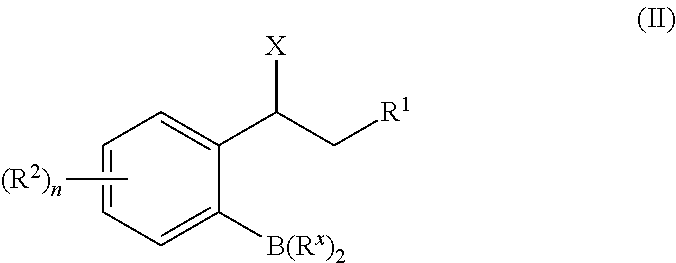Copper catalyzed halogenaton and reaction products
a technology of halogenaton and reaction products, which is applied in the direction of group 3/13 element organic compounds, group 5/15 element organic compounds, etc., can solve the problems of difficult stereochemistry of halogen-bearing carbon, lack of general and flexible approaches to asymmetric phosphines, and cost of precious metal portion of catalys
- Summary
- Abstract
- Description
- Claims
- Application Information
AI Technical Summary
Benefits of technology
Problems solved by technology
Method used
Image
Examples
example 1
Cu-Catalyzed Recycling of Halogen Activating Groups via 1,3-Halogen Migration
[0115]A Cu(I)-catalyzed 1,3-halogen migration reaction effectively recycles an activating group by transferring bromine or iodine from an sp2 carbon to a benzylic carbon with concomitant borylation of the Ar—X bond. The resulting benzyl halide can be reacted in the same vessel under a variety of conditions to form an additional carbon-heteroatom bond. Cross-over experiments using an isotopically enriched bromide source indicate intramolecular transfer of Br. The reaction proceeds via a Markovnikov hydrocupration of the o-halostyrene, oxidative addition of the resulting Cu(I) complex into the Ar—X bond, migration of the copper to the halogen-bearing carbon with accompanying dearomatization, then migration of the halogen to the benzylic carbon to re-establish aromaticity and generate an aryl copper(I) species, followed by a final borylation of an Ar—Cu(I) species to turn over the catalytic cycle.
[0116]Typical...
example 2
Copper-Catalyzed Enantioselective Transfer of Bromine via 1,3-Halogen Migration
[0130]In a typical coupling reaction, one new bond is formed at the expense of two functional groups as well as the generation of a waste product (Scheme 2-1, top). In the newly developed approach, all of the atoms from both coupling partners are incorporated into the final product via a 1,3-migration of the catalyst (Scheme 2-1, bottom).
X═Cl, Br, I
[0131]Z=nucleophiles such as azide, amines, alkoxides, thiols, phosphines, carbanions (e.g., malonates, enolates, etc.), and the like.
The phenyl group can also be substituted by 1-4 R groups, as in Formula (I) and Scheme 1-1.
[0132]In this transformation, the catalyst first adds across an olefin to generate a benzyl metal catalytic species. This intermediate then rearranges, breaking the aryl C—X bond (X═I, Br, or Cl) to form a benzyl C—X bond. The aryl catalyst species then forms a new aryl C—Y bond with a coupling partner. The benzyl C—X can then be displaced ...
example 3
Chiral Ligand Preparation
[0148]The hydrobromination methods described herein can be used to prepare both novel and commercially available ligands. The hydrobromination can be rendered enantioselective by use of an electron-rich, bulky, bidentate phosphine ligand such as (S,S)-Ph-BPE:
[0149]One commercially available chiral ligand that can be prepared using the methods described herein is (S)-1-(2-(diphenylphosphino)phenyl)ethanamine ((S,S)-Ph-BPE). The sequence requires only three steps to provide the commercially valuable ligand, as shown below in Scheme 3-1.
[0150]The ligand can be easily diversified, for example, by reactions at the amine (e.g., alkylations, conjugations, protections, etc.), at the methyl or phenyl ring (e.g., by selecting an alternative starting material with various substitution patterns), or at the phosphine, such as by using any of a wide variety of Grignard reagents. Various Grignard and related organometallic reagents and their methods of use are described by...
PUM
| Property | Measurement | Unit |
|---|---|---|
| enantiomeric excess | aaaaa | aaaaa |
| enantiomeric excess | aaaaa | aaaaa |
| temperatures | aaaaa | aaaaa |
Abstract
Description
Claims
Application Information
 Login to View More
Login to View More - R&D
- Intellectual Property
- Life Sciences
- Materials
- Tech Scout
- Unparalleled Data Quality
- Higher Quality Content
- 60% Fewer Hallucinations
Browse by: Latest US Patents, China's latest patents, Technical Efficacy Thesaurus, Application Domain, Technology Topic, Popular Technical Reports.
© 2025 PatSnap. All rights reserved.Legal|Privacy policy|Modern Slavery Act Transparency Statement|Sitemap|About US| Contact US: help@patsnap.com



